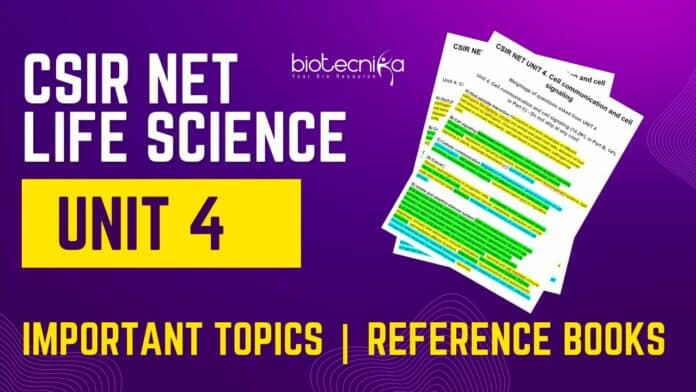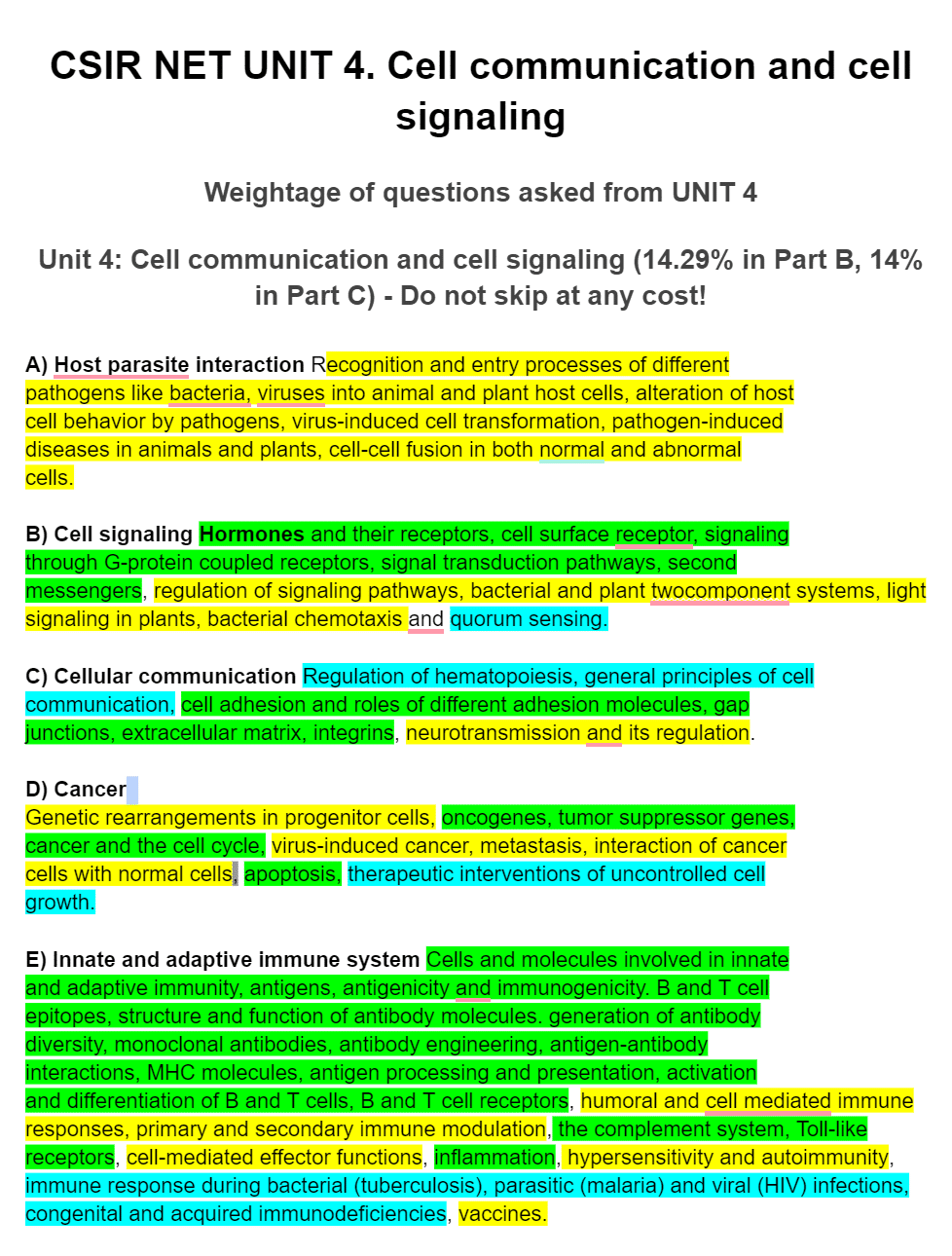CSIR NET Unit 4 Life Science: A Comprehensive Guide
Today, let’s dive into Unit Four of the CSIR syllabus, specifically focusing on CSIR NET Life Science UNIT 4 – Cellular Communication and Cell Signaling. We’ll discuss the important topics, the number of questions to expect in Parts B and C, and recommend some reference books to aid your preparation.
Table of Contents
Understanding the CSIR NET Life Science UNIT 4 Syllabus
The Unit Four syllabus is divided into five subunits, namely:
- A – Host-Parasite Interaction
- B – Cell Signaling
- C – Cellular Communication
- D – Cancer
- E – Immunology / Innate and adaptive immune system
While all subunits are crucial, B, C, D, and E are particularly important and often carry more weight in the exam. Now, let’s explore the expected number of questions from each subunit.
Expected Questions in CSIR NET Life Science Unit 4
| Subunit | Expected Questions | Type of Questions |
| A – Host-Parasite Interaction | 1-2 | Mostly Part C (Match the Following) |
| B – Cell Signaling | 3-5 | A mix of Part B and Part C |
| C – Cellular Communication | 3-4 | Combination of Part B and Part C |
| D – Cancer | 3-4 | A mix of questions in PART B & Part C and Experimental-Based Questions |
| E – Immunology | 1-2 | Part C and Experimental |
Now that we have an overview, let’s explore the important topics within each subunit.
Important Topics in UNIT 4
In CSIR NET UNIT 4 Syllabus Let’s break down the key topics in each section. We’ve color-coded them for importance –
- green is most important
- yellow is medium
- and blue is least important.
Starting with the first section on host-parasite interaction, it’s about diseases like bacterial and viral ones, their causes, and how they affect hosts. Questions might involve matching the following type of questions.
Moving on to the second part, all about cell signaling – this is a big deal. Look out for questions on GPCRs, the biggest family of proteins. They might ask about toxins related to GPCRs, and also about RTK and the JAK-STAT pathway. Expect ‘match the following’ questions about second messengers, ligands, and effector proteins.
In the third section on cellular communication, the key is the ECM components. It’s divided into cell-to-cell and cell-to-matrix interactions. Questions might pop up about cell adhesion molecules, and you’ll likely encounter ‘match the following’ questions here too.
Now, the fourth part is about cancer. They might throw questions at you about apoptosis, and other important stuff includes understanding the differences between oncogenes and tumor suppressor genes. They might ask about how a proto-oncogene turns into an oncogene, and how the cell cycle is tied to cancer. You could get questions on cancer viruses and ‘match the following,’ but they’re not as crucial.
Lastly, immunology is a bit tricky. Stick to the basics since most questions are experimental and conceptual. If you’ve covered diseases elsewhere, you can skip that part. Keep an eye out for the unexpected here.
Must Watch CSIR NET Life Science UNIT 4 Video
LIST OF IMPORTANT TOPICS FROM CSIR NET LIFE SCIENCE UNIT 4
A – Host-Parasite Interaction
- Bacterial and Viral Diseases
- Causative Agents
- Pathogens and Hosts
- Match the Following Questions
B – Cell Signaling
- G Protein-Coupled Receptors (GPCR)
- Toxins related to GPCR
- RTK (Tyrosine Kinase)
- JAK-STAT Pathway
- Ligands, effector proteins, and second messengers match the following questions seen in the recent past.
C – Cellular Communication
- Components of ECM (Extracellular Matrix)
- Cell-to-Cell and Cell-to-Matrix Interactions
- Cell Adhesion Molecules
- Match the Following Questions
- Direct questions are asked for both Part B and Part C most of the time.
D – Cancer
- Apoptosis
- Oncogenes vs. Tumor Suppressor Genes, along with examples
- Conversion of Proto-Oncogene to Oncogene
- Cell Cycle and Cancer
- Viruses Related to Cancer
- Comparison of Cancer Cells to Normal Cells
E – Immunology
- Basics of Immunology
- Experimental Questions
- Conceptual Checks
- Diseases Related to Immunology (optional)
Reference Books
Now, let’s explore some recommended reference books to enhance your preparation for CSIR NET Unit 4 Life Science.
- “Lehninger Principles of Biochemistry” by Nelson and Cox is a comprehensive guide covering all aspects of biochemistry, including cellular communication and signaling.
- “Molecular Cell Biology” by Lodish; Cell & Molecular Biology by Karp
- “Molecular Biology of the Cell” by Alberts et al. – Widely used in academic courses, this book provides in-depth coverage of cell biology, making it a valuable resource for Unit 4.
- “Immunology” by Kuby – A renowned book that covers immunology with clarity and depth, helping you grasp the fundamentals and stay prepared for any experimental questions.
Remember, these books are aids; ensure that you align your study with the CSIR syllabus. Always try to use the latest edition books to get more recent advancements or information.
In conclusion, Unit 4 of CSIR NET Life Science is a vital section that requires focused preparation. Understanding the weightage of each subunit, knowing important topics, and referring to reliable books can significantly enhance your chances of success. Best of luck with your preparation, and if you have any questions, feel free to reach out. Thank you.










































